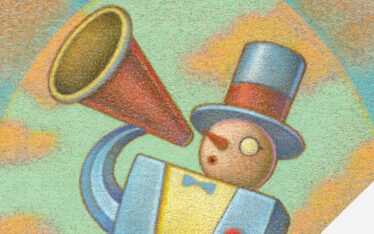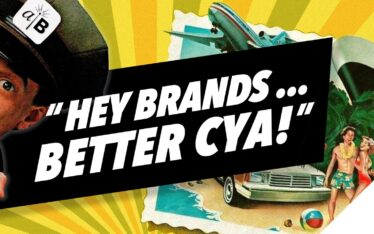
People prefer to engage with people rather than logos. To wit: The majority (76%) of Adweek survey participants said they’re more likely to trust content shared by individuals over content shared by brands.
It can be tough for a brand’s company page to create truly authentic engagements and build the level of trust that comes most naturally with human interactions.
That doesn’t mean you don’t need a company page.
We know that executives spend time on LinkedIn to learn from their peers, uncover industry insights, and to establish themselves as thought leaders. We also know that when they’re on the platform, they don’t want to be taken away from it. LinkedIn doesn’t want that either – that’s why it favors social posts that do not include a URL. According to Hootsuite research, posts without links get 6x more reach, 4x more reactions, and 18x more comments than posts with a link.
Your company page is the best way for LinkedIn users to learn more about your brand without leaving the platform. But the best way to connect with your audience is through personal connections. That’s where your executives come in.
CEOs and other c-suite executives are often viewed as unreachable. Still, they hold a great deal of influence within an organization. Teams depend on their leadership and look to them as experts in their field. Extending this influence to social media amplifies thought leadership and expertise. Not only is it good for their careers but it’s great for companies as well, both from a revenue and a recruiting standpoint.
In fact, statistics show that executives who are active on social media offer multiple benefits to their companies, from higher credibility (76% of senior execs) to purchase preference (77% of buyers) and stronger hiring/retention (80% of employees). And executives who engage regularly on LinkedIn show not only their reachability but their willingness to add value to conversations.
Your Marketing Strategy Should Include Executive LinkedIn Profiles
Personal social media profiles are more effective for generating awareness, demand, and leads for B2B companies. That’s because personal profiles are active where company pages are passive. Executives can reach out to prospects, have conversations, and build relationships from their LinkedIn profiles. Building followers increases their credibility as a thought leader, and adding connections allows them to build relationships with stakeholders and potential clients.
Your executives can also reach out to prospects via InMail – something you can’t do from your company page. Additionally, LinkedIn’s new Thought Leader Ads allow companies to boost employees’ posts on the platform with their permission. This is a great way to take advantage of your executive’s network and exponentially increase your brand’s reach.
How Executive Advocacy Differs from Employee Advocacy
Employee advocacy is critical to building your brand and reaching a greater percentage of your target audience. Employees, on average, have 10x more followers than corporate social accounts, according to LinkedIn. And your employees are likely already talking about your company on their social media profiles, so providing them with approved content to share helps to build your brand and ensure your brand standards are being followed.
Keep in mind, though, that consumers don’t care about brands, and they don’t trust NGOs, governments, or the media, but they do trust businesses. In fact, businesses are the only organizations that people believe to be ethical and competent, according to the 2023 Edelman Trust Barometer. Including your executives is a great way to encourage employees to participate in your advocacy program, but it’s often not enough to amplify your executives’ voices, build their thought leadership, and positively impact your brand’s reputation.
There is a trust gap when it comes to c-suite executives that requires authentic, human engagement to fill, which translates to a strong company reputation. And when it comes to reputation, consumers and buyers alike want CEOs and other c-suite executives to play a more visible role in your brand’s marketing strategy.
That means, in addition to providing brand content for employees to share via their personal social mediaprofiles, executives need a customized approach that allows them to shine a light on conversations, trends, and insights related to not only your brand but to their role in your company and their professional expertise. Building your executives’ presence as thought leaders can have a positive impact on your brand’s reputation, your customers, and your employees.
Here are 4 Best Practices for Creating an Executive Advocacy (Thought Leadership) Program
Best Practice #1: Empower Your Executives
When you empower your executives to build their personal brand, your organization can benefit from the halo effect of being associated with them. Your executives are busy, so instead of asking them to do more work, create a program that makes it easy for them to establish their thought leadership and breaks down barriers to social selling. If your executives aren’t comfortable writing LinkedIn posts yet, leave it to your social media marketing agency, but be sure to give your executives the decision-making power to review, approve, and/or edit posts to best fit their unique voice.
Best Practice #2: Customize the Content
Sure, asking your employees to share your brand’s content is what makes employee advocacy work. But your c-suite executives likely already have an established identity on the platform. That requires more careful curation of content that aligns with their role and experience. What you don’t want to do is make it look like your executives are simply pushing your company page content. The content they share can come from the company, but it should also come from credible third-party sources, and no matter what they share, it should always align to their industry and expertise. Before posting, ask yourself if this executive has the expertise and ability to talk about that topic.
Best Practice #3: Make it Personal
Your executives should absolutely be involved in selecting content to share socially and in shaping the narrative of each post. Think about the most effective public speaker you’ve listened to – I guarantee they wove personal stories into their presentation. Adding a personal anecdote draws audiences in and helps people connect and remember you. Ask your executives to draft a personal story or anecdote for each topic and weave it into their LinkedIn posts. If you’re not sure how to do this, hire a social media writer with strong storytelling chops. AI can help you come up with different ways to say something, but it can’t effectively take the place of a seasoned writer.
Best Practice #4: Remember It’s a Two-Way Street
Publishing LinkedIn posts is a great initiative toward building brand awareness and developing thought leadership, but it doesn’t start and end there. Executives who join industry conversations have the best success rates. So, go beyond just publishing by reading and commenting on other people’s social mediaposts. Not only will you develop a strong following, but you’ll also connect with like-minded professionals that much faster.
An executive Social Media thought leadership program allows leaders within your organization to build their own reputations as industry thought leaders while building brand credibility and amplifying their voices around your brand content. Consider that:
· 76% of senior execs believe having a CEO on social media gives the brand more credibility.
· 77% of buyers prefer to purchase from companies with socially active executives.
· 80% of employees would rather work for a leader who engages with people on social media.
Getting Started: The 20/5 Rule
Spend just 20 minutes a day, whether it’s first thing in the morning, at lunch time, or at the end of the workday, on LinkedIn and follow these 5 tips:
1. Pay attention to the content in your feed
2. Make time to read content that interests you
3. Take the time to comment on posts that resonate with you
4. Connect with those who comment on your posts
5. Share your company posts with a personal anecdote or intro
Offering your most valued executives a customized advocacy program can help them build their own thought leadership, boost your company culture and brand reputation, and improve talent branding and retention efforts.
Want to amplify your brand’s credibility and your executives’ expertise? The Social Savvy Executive guide shares case studies from four executives and one global B2B brand. Download a free copy for their pro tips to leveraging executive thought leadership.



